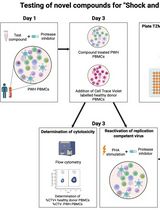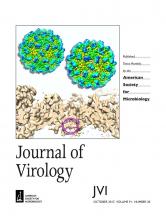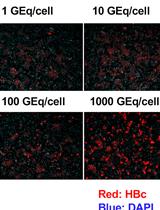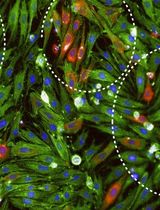- EN - English
- CN - 中文
Analysis of the Effect of Sphingomyelinase on Rubella Virus Infectivity in Two Cell Lines
在两细胞系中分析鞘磷脂酶对于风疹病毒感染力的影响
发布: 2018年09月05日第8卷第17期 DOI: 10.21769/BioProtoc.2992 浏览次数: 6018
评审: Vamseedhar RayaproluVaibhav B ShahSaumik Basu

相关实验方案

诱导型HIV-1库削减检测(HIVRRA):用于评估外周血单个核细胞中HIV-1潜伏库清除策略毒性与效力的快速敏感方法
Jade Jansen [...] Neeltje A. Kootstra
2025年07月20日 2392 阅读
Abstract
Rubella is a mildly contagious disease characterized by low-grade fever and a morbilliform rash caused by the rubella virus (RuV). Viruses often use cellular phospholipids for infection. We studied the roles of cellular sphingomyelin in RuV infection. Treatment of cells with sphingomyelinase (SMase) inhibited RuV infection in rabbit kidney-derived RK13 cells and African green monkey (Cercopithecus aethiops) kidney-derived Vero cells. Our data further demonstrated that RuV used cellular sphingomyelin and cholesterol for its binding to cells and membrane fusion at the step of virus entry. Detailed protocols of our assays, which assess the effects of SMase treatment on RuV infectivity in RK13 and Vero cells, are described.
Keywords: Rubella virus (风疹病毒)Background
Rubella virus (RuV) is a positive-strand RNA virus and belongs to the genus Rubivirus in the family Togaviridae. The family has two genera, Rubivirus and Alphavirus. RuV is the sole member of genus Rubivirus, whereas many viruses, such as Semliki forest virus (SFV) and Sindbis virus (SINV), are classified in the genus alphavirus. RuV is the causative agent of rubella and congenital rubella syndrome (CRS). Rubella is characterized by low-grade fever, a morbilliform rash, and lymphadenopathy. It is ordinarily a mild disease. However, CRS is a serious disease. CRS causes multiple organ defects in neonates born from mothers who suffered from rubella during the early phase of their pregnancy. Cataracts, sensorineural hearing loss and cardiovascular defects are common in CRS.
Previous studies suggested that cellular membrane lipids act as binding or entry factors for RuV infection (Mastromarino et al., 1989 and 1990), but the detailed mechanism has not yet been elucidated. Myelin oligodendrocyte glycoprotein (MOG) has been identified as a cellular receptor for RuV (Cong et al., 2011). However, the pathology of rubella cannot be solely explained by the usage of MOG because MOG is mainly expressed in the central nervous system and is barely expressed in other organs. Trinh et al. (2018) recently reported that RuV infects HaCat keratinocyte cells that do not express MOG on their surface.
Our recent study (Otsuki et al., 2018) demonstrated that RuV binds directly to sphingomyelin (SM) and cholesterol (SM/Chol)-enriched membranes in a Ca2+-dependent manner. Furthermore, the study showed that the binding is essential for membrane fusion at the early stage of rubella infection. In the current protocol, we provide a detailed method to examine whether the SM of host cells is essential for RuV infection in adherent cell lines. This protocol will be also useful to evaluate the use of host cellular SM in the infection of other viruses.
Materials and Reagents
- Materials
- A 6-well cell culture plate (Corning, catalog number: 3506 )
- A 12-well cell culture plate (Corning, catalog number: 3512 )
- A 24-well cell culture plate (Corning, catalog number: 3524 )
- Pipette tips (Neptune Scientific, catalog numbers: BT20 , BT200 and BT1250 )
- A 1.5 ml tube with lid (INA•OPTIKA, catalog number: ST-0150F )
- Cells
- RK13 cells: these cells were a gift from the Kitasato Institute
Note: These cells are maintained in Eagle’s minimum essential medium (MEM) (see Recipes) containing 8% bovine serum (BS). - Vero cells: our pre-existing stocks were originally obtained from American Type Culture Collection and have been maintained for more than 20 years in our laboratory
Note: These cells are maintained in Dulbecco’s modified Eagle’s medium (DMEM) containing 5% fetal bovine serum (FBS), 100 unit/ml Penicillin, and 100 μg/ml Streptomycin.
- RK13 cells: these cells were a gift from the Kitasato Institute
- Viruses
- Rubella virus (RuV) TO-336 vaccine strain (Takeda Pharmaceutical) (Otsuki et al., 2011)
- RuV RVi/Hiroshima.JPN/01.03 wild type strain (Otsuki et al., 2011; Sakata et al., 2014)
- The recombinant RuV RVi/Hiroshima.JPN/01.03 strain expressing the green fluorescent AG1 protein (rHS/p150-AG1) (reported previously in Sakata et al., 2014)
- The recombinant measles virus (MeV) and human metapneumovirus (HMPV) expressing enhanced green fluorescent protein (EGFP) (MeV-IC323/Ed-H-EGFP and HMPV-rJPS02-76EGFP, respectively) (reported previously in Seki et al., 2006 and Shirogane et al., 2008)
Notes:- The TO-336 vaccine strain and RVi/Hiroshima.JPN/01.03 wild type strain were propagated in RK13 cells. The recombinant rHS/p150-AG1 was propagated in Vero cells. MeV and HMPV were propagated in Vero/hSLAM cells (Ono et al., 2001) and Vero/TMPRSS2 cells (Shirogane et al., 2008), respectively.
- Viruses were diluted with MEM before use.
- Virus-like particles of RuV (RuV-VLP)
RuV-VLP, whose genome encodes Renilla luciferase and AG1 reporter genes, were produced and concentrated as described previously (Sakata et al., 2014), with some modifications (Otsuki et al., 2018). - Reagents
- Eagle’s MEM “Nissui” 1 (NISSUI PHARMACEUTICAL, catalog number: 05900 )
- Dulbecco’s modified Eagle’s medium (Sigma-Aldrich, catalog number: D5796 )
- Dulbecco’s phosphate buffered saline (DPBS) (Thermo Fisher Scientific, GibcoTM, catalog number: 14190144 )
- Fetal bovine serum (Biowest, catalog number: S1780-500 )
- Bovine serum (Thermo Fisher Scientific, GibcoTM, catalog number: 16170078 )
- Penicillin-streptomycin (Thermo Fisher Scientific, GibcoTM, catalog number: 15140122 )
- L-Glutamine (200 mM) (Thermo Fisher Scientific, GibcoTM, catalog number: 25030081 )
- Agarose ME (IWAI CHEMICALS, catalog number: 50013R )
- 7.5% sodium bicarbonate (Thermo Fisher Scientific, GibcoTM, catalog number: 25080094 )
- Sphingomyelinase from Bacillus cereus (Sigma-Aldrich, catalog number: S9396 )
- Neutral red solution (0.33%) (Sigma-Aldrich, catalog number: N2889 )
- Renilla Luciferase Assay system (Promega, catalog number: E2810 )
Note: Lysis buffer and Renilla Luciferase Assay Reagent are included in this kit. - MEM (see Recipes)
- 2x MEM (see Recipes)
- MEM containing 2% BS (or FBS) and 0.5% (or 0.4%) agarose (see Recipes)
- MEM containing 0.01% neutral red and 0.5% agarose (see Recipes)
Equipment
- Micropipettes (Gilson, models: P10, P200, P1000, catalog numbers: F144802 , F123601 , F123602 )
- Luminometer (Promega, model: GloMax® 20/20 )
- Autoclave (TOMY SEIKO, model: ES-215 )
- Biosafety cabinet (Air Tech)
- Cell culture incubator (at 35 °C and 37 °C with 5% CO2) (Thermo Fisher Scientific, Forma, model: 310 )
- Fluorescence microscope (ZEISS, model: Axio Observer D1 )
- Cell culture microscope (Olympus, model: CKX53 )
Procedure
文章信息
版权信息
© 2018 The Authors; exclusive licensee Bio-protocol LLC.
如何引用
Otsuki, N., Sakata, M., Mori, Y., Okamoto, K. and Takeda, M. (2018). Analysis of the Effect of Sphingomyelinase on Rubella Virus Infectivity in Two Cell Lines. Bio-protocol 8(17): e2992. DOI: 10.21769/BioProtoc.2992.
分类
微生物学 > 抗微生物试验 > 抗病毒试验
细胞生物学 > 基于细胞的分析方法 > 病毒性感染
您对这篇实验方法有问题吗?
在此处发布您的问题,我们将邀请本文作者来回答。同时,我们会将您的问题发布到Bio-protocol Exchange,以便寻求社区成员的帮助。
Share
Bluesky
X
Copy link












